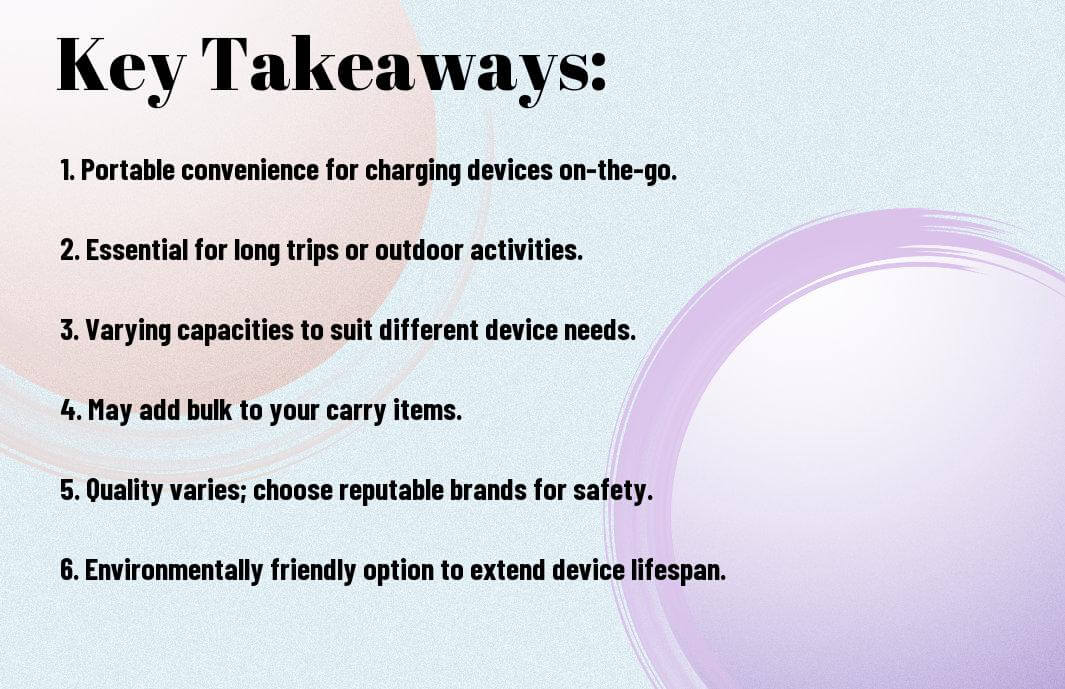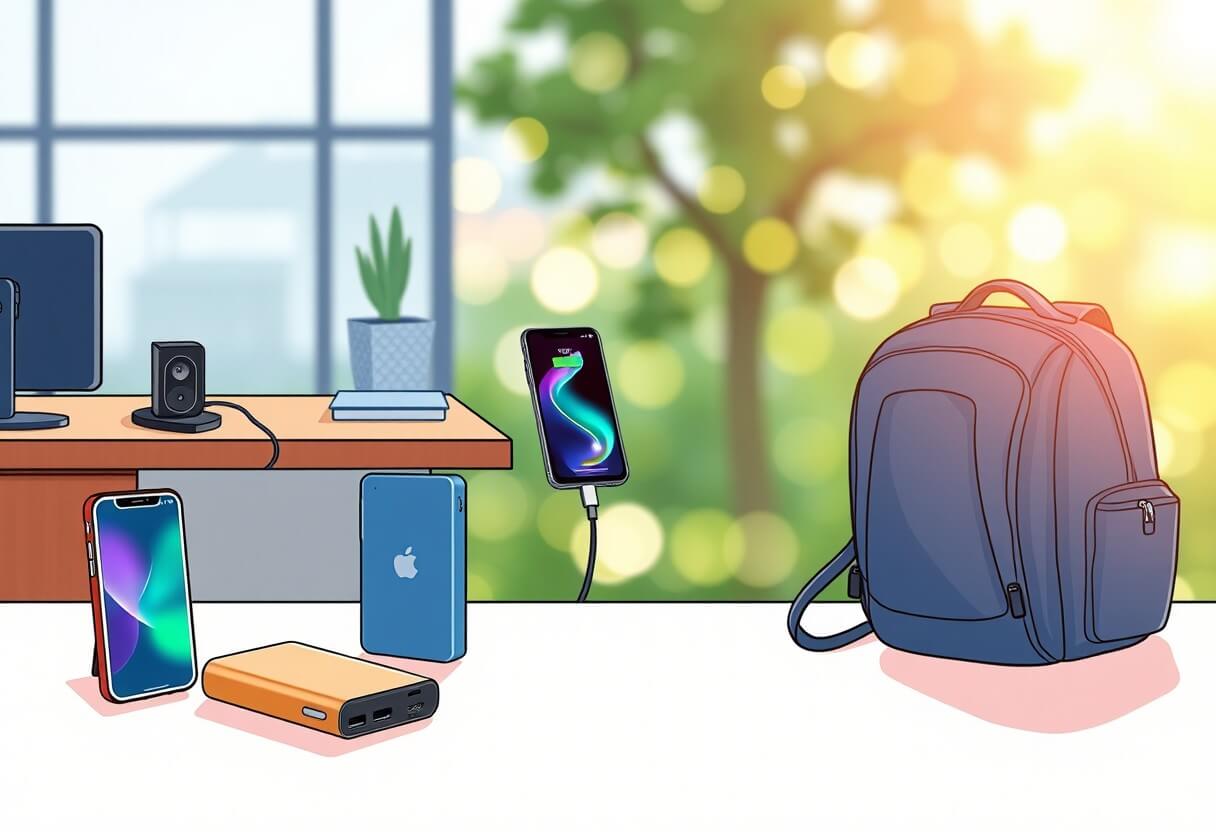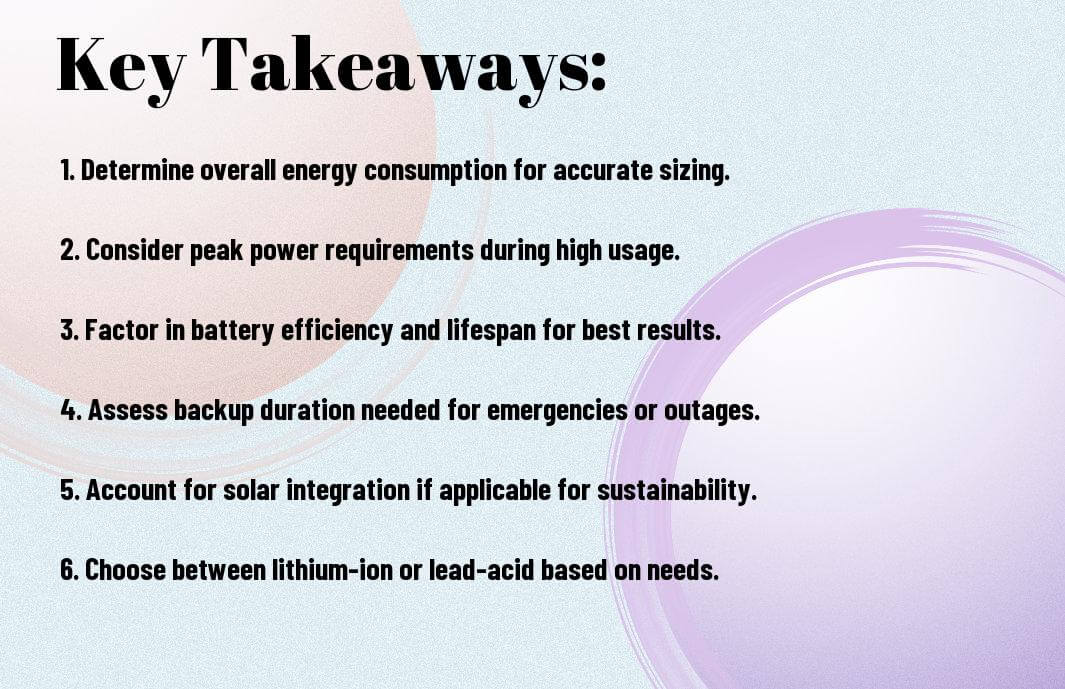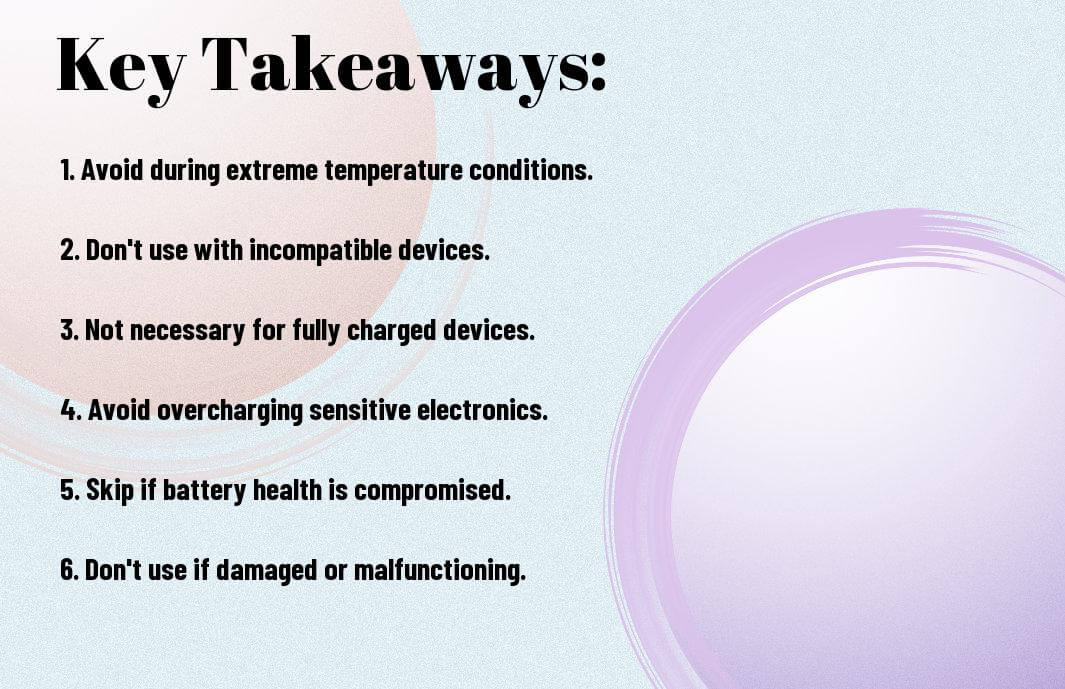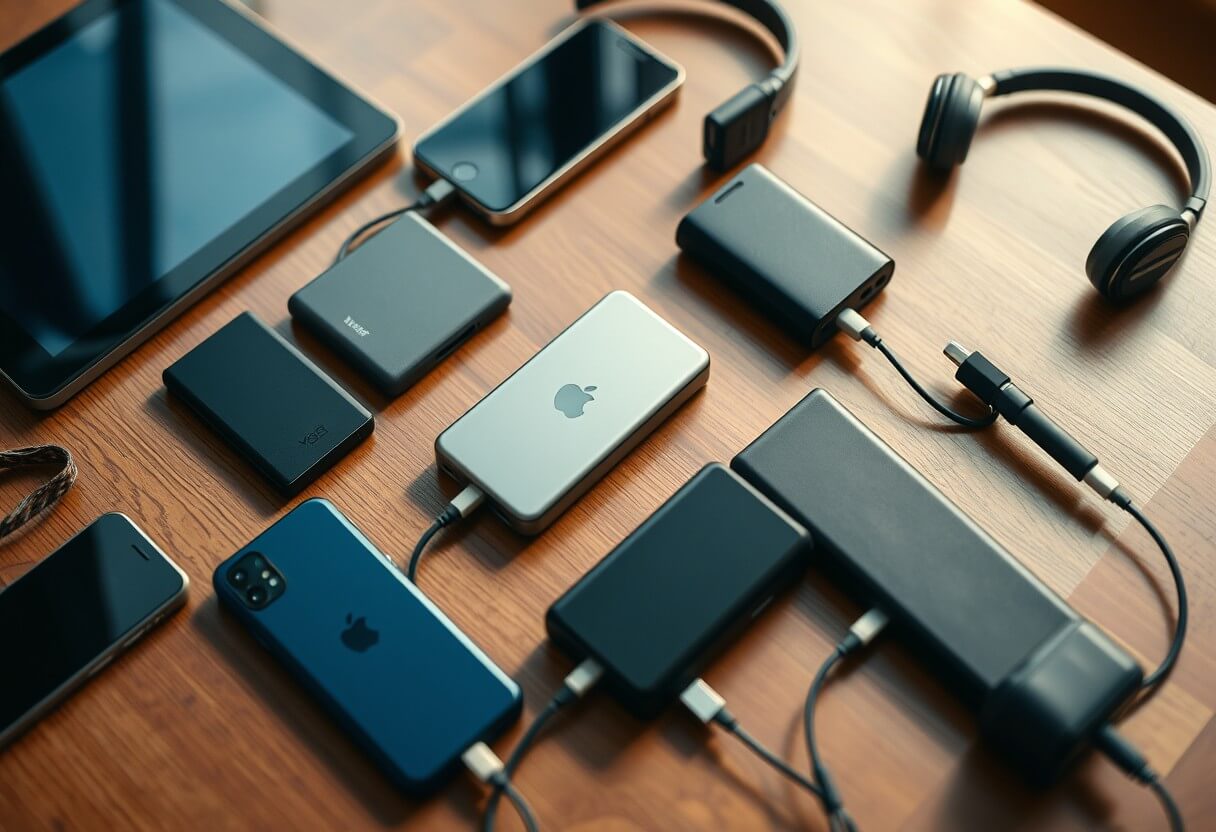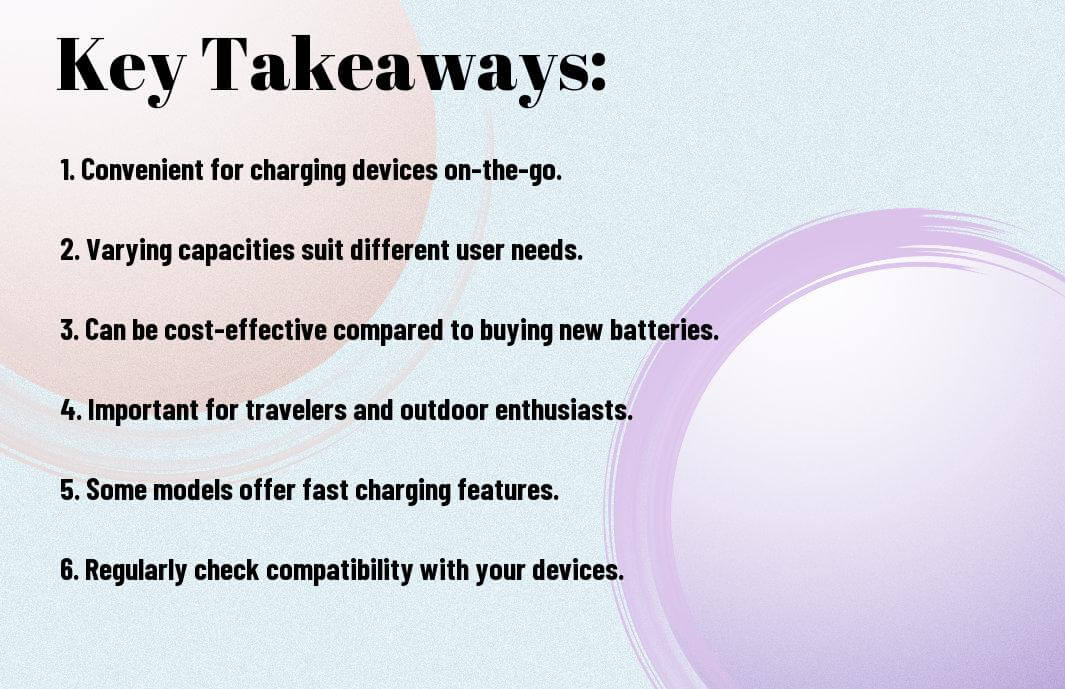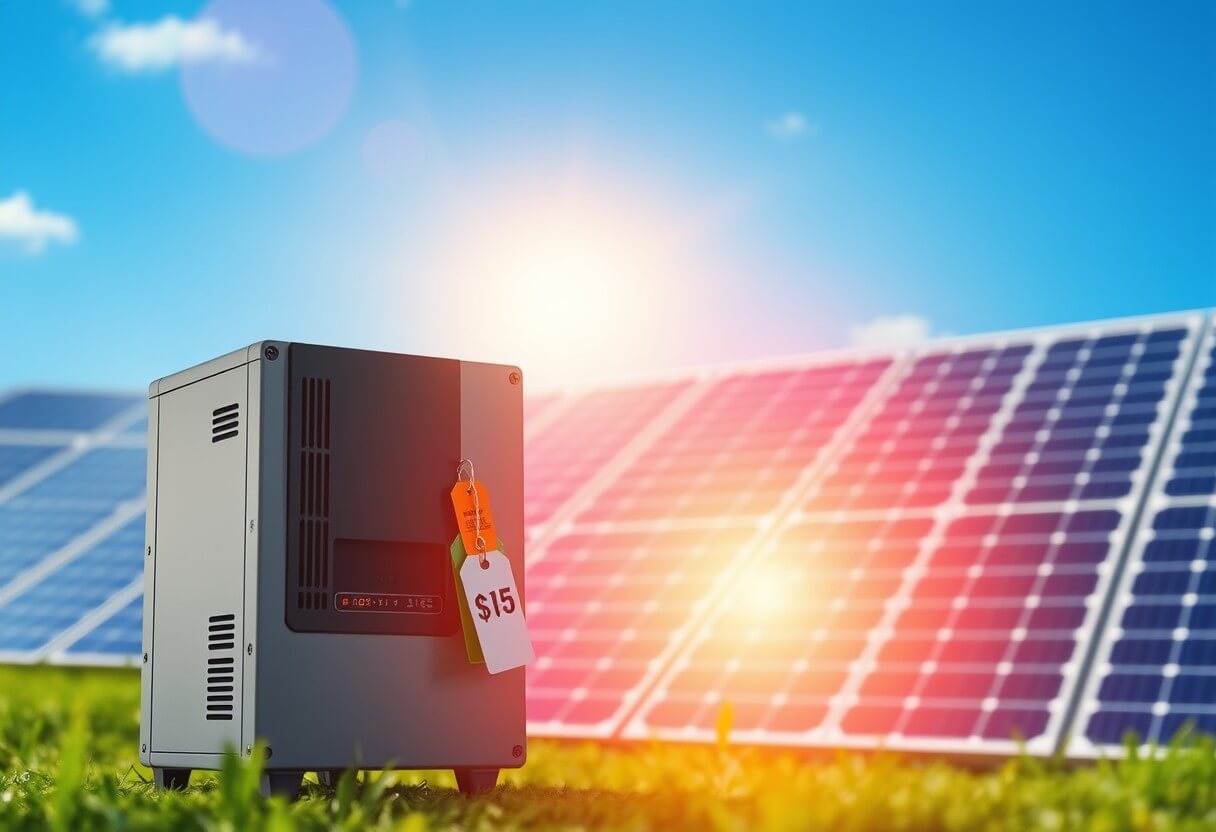Many people rely on their mobile devices for communication, navigation, and entertainment, making battery life a critical concern. As you navigate through your daily activities, you may find yourself questioning whether power banks are a practical solution for your charging needs. In this blog post, we will explore the benefits and potential drawbacks of using power banks, helping you determine if they are a worthwhile investment for your lifestyle.
Key Takeaways:
- Convenience: Power banks provide a reliable and portable solution for charging devices on-the-go, making them a great idea for travelers and busy individuals.
- Capacity: The capacity of power banks varies widely; selecting one with sufficient mAh (milliamp hours) can ensure multiple charges for your device.
- Compatibility: Most modern power banks are designed to work with a variety of devices, but it’s crucial to check compatibility with your specific gadgets.
- Safety Features: High-quality power banks come with built-in safety features such as short circuit protection and overcharge protection, enhancing user safety.
- Price vs. Quality: Investing in a reputable brand may cost more upfront, but it can provide better performance and longevity compared to cheaper alternatives.
Understanding Power Banks
As technology continues to advance, you may find yourself increasingly reliant on your devices. Understanding the various accessories available to keep your gadgets powered is important, particularly in our fast-paced world. One such accessory that has gained immense popularity is the power bank. Here, we will explore into what power banks are, how they function, and the different types available to help you determine if investing in one is worthwhile.
Definition and Functionality
Power banks are portable battery chargers designed to store electrical energy in a compact, travel-friendly device. They allow you to recharge your electronic gadgets, such as smartphones, tablets, and other USB-powered devices, while on the go. By connecting your device to the power bank using a charging cable, the stored energy can be transferred to keep your device operational without needing a wall outlet.
The functionality of a power bank largely hinges on its capacity, typically measured in milliampere-hours (mAh). The higher the mAh rating, the more power it can store, and consequently, the more times it can influence your devices. Therefore, selecting a power bank with an appropriate capacity that aligns with your usage patterns is crucial.
Types of Power Banks
There are various types of power banks available, each catering to different needs and preferences. Understanding the distinctions will help you choose the one that best complements your lifestyle. Below is a breakdown of some of the common types you might encounter:
| Type | Description |
| Standard Power Bank | Basic design, varying capacities, suited for regular charging needs. |
| Fast Charging Power Bank | Supports quicker charging speeds, ideal for devices that require high power. |
| Solar Power Bank | Utilizes solar panels to recharge, great for outdoor activities. |
| Wireless Power Bank | Allows for charging without cables, utilizing Qi technology. |
| Multi-Port Power Bank | Features multiple output ports for charging several devices simultaneously. |
Choosing the right power bank often requires considering what fits your charging habits and lifestyle. The multitude of options allows you to select one that will cater specifically to your needs, whether you require something portable for day trips or a high-capacity model for extended weekends away.
- Standard power banks can still meet the average user’s needs.
- Fast charging is perfect for those who are always in a hurry.
- Solar power banks are eco-friendly and great for outdoor enthusiasts.
- Wireless power banks eliminate the hassle of tangled cords.
- Multi-port power banks offer versatility for families or multiple devices.
Thou need to weigh the pros and cons of each type, ensuring you select one that harmonizes with your daily activities.
Advantages of Using Power Banks
Now, let’s explore the advantages of using power banks to keep your devices charged and ready to go. In a world where staying connected is crucial, having a portable power solution can significantly enhance your experience, whether you’re on the go, traveling, or facing unexpected power shortages. Power banks provide a simple and effective way to ensure that your devices have enough juice to last throughout the day.
Convenience and Portability
One of the most significant advantages of using a power bank is the convenience and portability it offers. You can easily carry a power bank in your bag or even in your pocket, allowing you to charge your smartphone, tablet, or other devices anywhere you go. This is particularly beneficial when you are out and about, whether you are commuting, traveling, or attending a long meeting. With a power bank, you are no longer tethered to an electrical outlet, which means you can keep your devices charged without worrying about finding a power source.
Furthermore, power banks come in a variety of sizes and capacities, so you can choose one that best fits your lifestyle. From slim models that can slip into your pocket to larger, more powerful units designed to charge multiple devices at once, there’s a power bank that can suit your needs perfectly. This flexibility in sizes and capacities ensures that you will have the right power solution, no matter the situation.
Emergency Backup Power
Emergency situations can arise at any moment, and having a power bank can be a lifesaver. If you find yourself in a situation where power is suddenly unavailable—whether due to a natural disaster, a power outage, or a long flight with no charging stations—your power bank can provide the vital backup power you need. It gives you peace of mind, knowing that you can contact loved ones, check on important updates, or navigate your way in unfamiliar places without fearing that your device will die.
Advantages like these highlight the importance of being prepared for the unexpected. A fully charged power bank can keep you connected during emergencies, ensuring that you can reach out for help or get information as needed. This makes power banks not only a handy accessory but also a reliable tool for ensuring you are never without power when you need it most.
Compatibility with Multiple Devices
Devices today are increasingly diverse, and you likely own more than just a smartphone. Laptops, smartwatches, and tablets are all part of your tech arsenal. Thankfully, most modern power banks are designed with compatibility in mind, allowing you to charge multiple devices without needing numerous chargers. This feature streamlines your charging process and reduces clutter since you can rely on one power bank for all your devices.
Plus, many power banks come equipped with multiple output ports and different charging cables. You can charge your smartphone while someone else charges their tablet or smartwatch simultaneously. This versatility can save time and make group travel or shared environments much easier when it comes to managing battery life for multiple devices.
Increased Battery Life for Travelers
Any frequent traveler understands the struggle of keeping devices charged while on the move. Whether you are on a long flight, waiting at an airport, or navigating through a busy city, your device’s battery life can diminish rapidly. A power bank can be your best ally in these scenarios, allowing you to recharge your devices while you go about your day. This means you can stay entertained during travel, access maps, or manage your work without constantly worrying about your battery level.
Power banks help ensure that you make the most of your travels without having to frequently seek out charging stations. Having a reliable power source lets you capture unforgettable moments, stay connected with friends and family, or even work on presentations while traveling. By investing in a powerful portable charger, you’re ensuring that you keep your device’s battery life maximized throughout your journey.
Disadvantages of Power Banks
Despite their convenience, power banks come with several disadvantages that you should consider before relying on them as your primary charging solution. Understanding these drawbacks can help you make an informed decision about whether a power bank is the right choice for your needs.
Charge Capacity Limitations
On the surface, power banks seem to solve the problem of running out of battery life; however, they are not without their limitations. The charge capacity of power banks varies significantly, and many models are designed to provide only one full charge to average smartphones. If you tend to use your device heavily throughout the day, you may find that a power bank does not hold enough juice to fully recharge your device, leaving you dependent on finding another charging source sooner than you anticipated.
Additionally, the milliamp-hour (mAh) rating of the power bank can greatly affect its performance. A lower-rated power bank might struggle to charge high-capacity devices, such as tablets or newer smartphones that require more energy. Therefore, it is crucial to select a power bank that meets the battery needs of your devices, which can be a daunting task given the plethora of options available.
Potential Quality Issues
Quality can vary significantly across different brands and models of power banks, leading to concerns about durability and performance. You might experience issues with charging speed, battery life, or even compatibility with your devices if you purchase a subpar power bank. In some cases, lower-quality options may use inferior components that can fail or degrade quickly over time, resulting in an unreliable charging experience that can leave you in a bind.
This inconsistency is particularly troubling when you consider that you may rely on a power bank during crucial moments, such as while traveling or in emergencies. If you invest in a low-quality product, you run the risk of ending up with a unit that can’t deliver the performance you need when you need it most.
Risk of Overheating
Banks can pose a risk of overheating, especially during charging or discharging cycles. While modern power banks come equipped with safety measures to prevent overheating, there is always a risk, particularly with low-cost units. When a power bank overheats, it can not only damage the power bank itself but may also pose a danger to your device and, in extreme cases, even present a fire hazard.
With continual usage or poor-quality manufacturing, overheating can become more prevalent over time. It is advisable to regularly inspect your power bank for any signs of swelling or excessive heat during operation, as these could indicate a serious issue with the device.
Dependence on Charging Opportunities
One of the less obvious disadvantages of power banks is the dependence they create on available charging opportunities. While you may have the convenience of charging on-the-go, there may still be circumstances where you require access to an electrical outlet to recharge your power bank itself. If you frequently find yourself in places without easy access to power, such as during long hikes or road trips, you may find that your reliance on a power bank is not as convenient as it seems.
Opportunities for charging your power bank can also become a limiting factor. If you are away from home for an extended period and your power bank runs out, you may find yourself unable to recharge it without a reliable source of power. This can leave you without a backup option for your devices when you need it most, undermining the reliability that power banks are meant to provide.
Choosing the Right Power Bank
Your decision to invest in a power bank should start with an honest assessment of your power needs. Not all power banks are created equal, and the right one for you will depend on how you plan to use it. Do you frequently travel for extended periods, or do you simply need a backup for daily use? Are you charging just a smartphone, or do you require a power supply for tablets and other devices? Understanding these requirements will help you narrow down your options effectively.
Assessing Your Power Needs
Power requirements vary widely among devices, so identifying yours is crucial. Smartphones typically range from 3,000 to 5,000 mAh for a full charge, while tablets and laptops may require much more. Take a moment to calculate how many times you need to recharge your devices during your outings. For example, if you’re planning a weekend camping trip and need to charge a phone multiple times, your choice in power bank capacity will be significantly different than if you’re just needing a quick charge during a workday.
Capacity and Output Considerations
With your power needs assessed, the next step is to investigate into the capacity and output of potential power banks. Battery capacity is generally measured in milliamp-hours (mAh), indicating how much charge the power bank can hold. The higher the mAh rating, the more storage it contains, allowing for more device charges over time. Furthermore, consider the output power, usually measured in volts and amps, which determines how fast your devices will charge. A power bank with a high output can significantly reduce downtime while you’re on the go.
For instance, if you have a smartphone that supports fast charging, you would want a power bank that offers a higher output to utilize that feature fully. Otherwise, you may end up with a power bank that takes much longer to top off your device’s battery. A good practice is to match the output of the power bank to the requirements of your devices to ensure optimal charging performance.
Brand Reputation and Reviews
Assessing the reputation of the brand you’re considering can play a critical role in your decision-making process. Popular brands often have customer feedback and expert reviews available, providing insight into the performance and reliability of their products. If a brand has consistently positive reviews and an established reputation in the market, it generally signifies that they produce quality power banks that meet consumer expectations. On the other hand, lesser-known brands might offer competitive prices, but the lack of reliable reviews can leave you second-guessing your purchase.
Reputation alone isn’t everything, but it does serve as a good indicator of what to expect from a product. A power bank from a well-regarded manufacturer typically comes with better customer service, warranties, and insights into how their technology stands up over time. Therefore, researching and reading reviews can save you from potential pitfalls when selecting a power bank.
Price vs. Quality Analysis
Brand value often reflects in the price of their products. Choosing a power bank that is too cheap might lead to compromises in quality, reliability, and safety features. You want to ensure that the power bank you select is worth the investment, balancing price with the technological features that suit your needs. Investing in a reputable brand may result in a higher upfront cost but often yields better performance and durability in the long run, proving more cost-effective over time.
Capacity plays a significant role in this balance. While it may be tempting to purchase a low-priced option with a high capacity, it could be lacking in safety features or charging efficiency. Therefore, it’s imperative to weigh the features against the price to find the right power bank for your needs while ensuring you’re not compromising on quality.
Best Practices for Power Bank Usage
For anyone who relies on a power bank, understanding best practices can significantly enhance its efficiency and lifespan. By integrating a few simple habits into your routine, you can make your power bank a reliable companion for all your charging needs. Proper maintenance, charging techniques, and responsible disposal methods are crucial to ensure that your power bank serves you well over time.
Maintenance Tips for Longevity
Practices to maintain your power bank are crucial for extending its usability. Firstly, ensure that you store your power bank in a cool, dry place, away from direct sunlight or heat sources. Overheating can damage the internal battery and reduce its lifespan. Secondly, avoid fully depleting the battery before recharging it, as this can lead to stress on the battery. Instead, try to recharge it when it reaches around 20% capacity.
- Clean the power bank regularly to avoid dust accumulation.
- Avoid using a power bank while it’s charging; this can cause overheating.
- Limit exposure to extreme temperatures, particularly while in use.
The longevity of your power bank largely depends on how well you maintain it through these simple practices.
Proper Charging Techniques
Any user can benefit from understanding proper charging techniques to maximize the effectiveness of their power bank. Be mindful of the type of cables and adaptors you use; original or high-quality accessories can make a significant difference in speed and safety. When you’re not in a hurry, opt for slower charging to lessen heat generation and prolong battery life. Additionally, avoid charging your power bank overnight unless it has an automatic shut-off feature.
For instance, charging your power bank in shorter bursts instead of leaving it plugged in for long periods can help maintain battery health. This approach keeps the battery from reaching full discharge statuses repeatedly, which may degrade performance over time. Always make sure to check the voltage and current specifications of your devices to avoid any mismatches that could lead to damage.
Safe and Responsible Disposal
One crucial aspect that many users overlook is the safe and responsible disposal of power banks once they reach the end of their life cycle. You should never throw your power bank in the regular trash, as it can leak harmful chemicals into the environment. Instead,look for local e-waste recycling programs or designated drop-off locations that handle lithium-ion batteries safely. Familiarize yourself with the disposal regulations in your area.
Disposal is a crucial step in ensuring that your electronic waste does not end up harming the planet. Many manufacturers and retailers offer take-back programs, where you can return your used power bank for recycling. Always check for the best options available to you to help reduce electronic waste and contribute to a more sustainable future.
Alternatives to Power Banks
To explore the options available for keeping your devices charged without relying solely on power banks, consider various alternatives that can cater to your specific needs and lifestyle. There are methods and gadgets that can provide a reliable charge without the bulk of a portable power bank. One such option is to investigate the differences between different charging products. You might find it beneficial to read about Power Bank vs Portable Charger: Are They the Same? to understand the distinct features available in the market.
Mophie Cases and Built-in Batteries
For those who constantly find their phones near depletion, Mophie cases or other similar products equipped with built-in batteries can be an ideal solution. These cases not only protect your device but also provide extra battery life when you need it most. This option eliminates the need to carry around multiple devices and keeps your phone fully operational throughout the day.
Moreover, built-in battery cases are designed to integrate seamlessly with your device’s charging capabilities, offering a more compact solution compared to traditional power banks. This way, you have one less device to manage, making your day just a bit easier.
Car Chargers
Any driver will appreciate the convenience of car chargers. These devices allow you to charge your phone or tablet while you’re on the road, ensuring that your device stays charged even during long commutes or road trips. Car chargers usually plug into your car’s power outlet and can provide a quick charge, keeping your devices ready for use as soon as you arrive at your destination.
This option not only helps keep your devices charged but also can be a lifesaver in emergencies. If you’re on a long drive and your phone battery runs low, a car charger can quickly replenish it, allowing you to stay connected and navigate as needed.
Wireless Charging Solutions
Power banks aren’t the only way to go cordless. Wireless charging solutions have gained significant traction, enabling you to charge your devices without the hassle of cables. These charging pads and stands allow you to simply place your phone or compatible device on them, and they begin to charge automatically. This is particularly beneficial if you prefer a clutter-free environment.
Solutions such as wireless charging docks can also integrate with other devices, allowing you to charge multiple gadgets at once. In addition to convenience, they often come with design elements that make them aesthetically pleasing – a stylish addition to your workspace or bedside table.
Battery Packs and Jump Starters
Packs that function as battery packs and jump starters can be another great alternative to standard power banks. These devices provide significant power for charging larger devices like laptops or even jumpstarting your car in an emergency. The versatility they offer makes them a worthy investment, especially for those who find themselves in a variety of situations needing extra power.
Chargers of this type usually come equipped with multiple charging ports and can accommodate various types of devices. Besides charging your electronics on the go, they serve as a backup for automotive emergencies, making them a multi-functional tool you may want to consider for both convenience and safety.
Final Words
Conclusively, power banks are indeed a smart investment for anyone who relies on electronic devices throughout their day. Whether you’re traveling, commuting, or simply away from an outlet, having a reliable power bank ensures that your devices remain charged and ready for use. You can’t afford to miss an important call or a moment of inspiration simply because your phone’s battery is dead. By choosing a power bank with enough capacity to meet your needs, you can take control of your device’s battery life and keep yourself connected without the constant worry of running out of power.
Moreover, as you explore various options for power banks, it’s beneficial to consider factors such as charging speed, portability, and capacity. These elements not only impact your convenience but also enhance your experience while using your gadgets. For additional insights and user experiences, you might find the Power Bank thoughts – Rick Steves Travel Forum helpful. By being well-informed, you can make the right decision about which power bank best suits your lifestyle, ultimately ensuring you stay powered up and engaged with the world around you.
FAQ
Q: Are power banks a good idea for daily use?
A: Yes, power banks can be a great idea for daily use, especially for individuals who rely heavily on their electronic devices. They provide a portable and convenient way to charge smartphones, tablets, and other gadgets on the go, ensuring that you never run out of battery when you need it most. With various capacities available, users can choose the right power bank that fits their needs, whether it’s for daily commuting or long trips.
Q: What should I consider when choosing a power bank?
A: When choosing a power bank, consider the following factors: capacity (measured in mAh, or milliamp hours), which determines how much charge the power bank can hold; output power (measured in Watts), as it affects how fast your device will charge; the number of ports, allowing you to charge multiple devices at once; size and weight for portability; and safety features such as overcharge protection to prevent damage to your devices.
Q: Can power banks harm my device’s battery life?
A: Generally, using a reputable power bank should not harm your device’s battery life. However, using low-quality or unverified power banks can potentially harm your device, as they might not adhere to proper charging standards. Always choose a power bank from a trusted brand, and ensure it has the necessary safety features to protect your devices during charging.
Q: Are there any compatibility issues with power banks?
A: Most power banks are compatible with a wide range of devices, including smartphones, tablets, and wearable technology. However, it’s important to check the power output and connector type of the power bank to ensure it matches your device. For example, some devices may require a specific output or connector type (like USB-C, Lightning, or Micro-USB) for optimal charging. Always verify compatibility before purchasing.
Q: Is it worth investing in a high-capacity power bank?
A: Investing in a high-capacity power bank can be worth it, especially if you frequently travel or use multiple devices. High-capacity power banks can charge your devices multiple times before needing a recharge themselves, making them ideal for long trips, camping, or days out. However, if you primarily use your device for short periods, a lower-capacity power bank might suffice. Evaluate your usage patterns to make the best decision for your needs.

